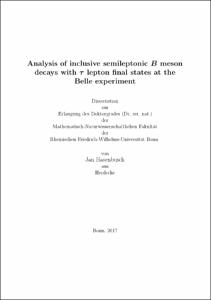Hasenbusch, Jan: Analysis of inclusive semileptonic B meson decays with τ lepton final states at the Belle experiment. - Bonn, 2018. - Dissertation, Rheinische Friedrich-Wilhelms-Universität Bonn.
Online-Ausgabe in bonndoc: https://nbn-resolving.org/urn:nbn:de:hbz:5n-51016
Online-Ausgabe in bonndoc: https://nbn-resolving.org/urn:nbn:de:hbz:5n-51016
@phdthesis{handle:20.500.11811/7578,
urn: https://nbn-resolving.org/urn:nbn:de:hbz:5n-51016,
author = {{Jan Hasenbusch}},
title = {Analysis of inclusive semileptonic B meson decays with τ lepton final states at the Belle experiment},
school = {Rheinische Friedrich-Wilhelms-Universität Bonn},
year = 2018,
month = jun,
note = {In this thesis, the measurement of the inclusive branching fraction of B→Xτν decays at the Belle experiment is presented. Previous measurements of the inclusive semileptonic b-hadron branching fraction BR(b→Xτν) in Z0→bb decays at LEP agree well with the prediction of the Standard Model of particle physics. Conversely, the B-factory experiments BaBar, Belle and LHCb consistently measured the exclusive branching fractions of the decays B→Dτν and B→D*τν larger than the theoretical prediction. The combined exclusive branching fraction measurements together exceed the Standard Model by 4σ and are even larger than the average of inclusive LEP measurements.
This work is the first measurement of the branching fraction of B→Xτν decays at a B-factory. It is therefore a valuable cross check to the exclusive analyses and also probes the inclusive LEP measurements in a different experimental environment.
At Belle, a large sample of 770 million BB pairs was recorded in e+e- collisions at the Υ(4S) resonance. One of the two B mesons in the BB event is fully reconstructed in a hadronic decay mode (Btag) and the other one (Bsig) is analysed regarding the signal decay. This hadronic B tagging allows one to constrain the kinematics and the flavour of the signal B meson and enables the study of observables in the Bsig rest frame. The signal is selected in the leptonic decay modes of the τ and thus signal-like events are required to have a single electron or muon in the final state.
This analysis relies on Monte Carlo simulations of backgrounds, particularly on those of semileptonic B decays. The latter produce mainly charmed mesons of which ~25% are the poorly known D** mesons. To improve the modelling of the data, a new model of these excited charmed mesons and the related semileptonic B decays is developed and implemented in dedicated Monte Carlo samples.
Observables for the signal extraction are the lepton momentum and the squared sum of four-momenta of undetected particles (squared missing mass) in the event. The signal branching fraction is measured, normalised to the branching fraction of B→Xlν (l = e, μ) decays, to be R(X) = BR(B→Xτν)/BR(B→Xlν) = 0.298 ± 0.012(stat) ± 0.018(sys). Assuming the isospin-average branching fraction BR(B→Xlν) = (10.86 ± 0.16)%, this translates to a branching fraction of BR(B→Xτν) = (3.23 ± 0.13(stat) ± 0.21(sys))% and is the most precise single measurement of B→Xτν decays so far.},
url = {https://hdl.handle.net/20.500.11811/7578}
}
urn: https://nbn-resolving.org/urn:nbn:de:hbz:5n-51016,
author = {{Jan Hasenbusch}},
title = {Analysis of inclusive semileptonic B meson decays with τ lepton final states at the Belle experiment},
school = {Rheinische Friedrich-Wilhelms-Universität Bonn},
year = 2018,
month = jun,
note = {In this thesis, the measurement of the inclusive branching fraction of B→Xτν decays at the Belle experiment is presented. Previous measurements of the inclusive semileptonic b-hadron branching fraction BR(b→Xτν) in Z0→bb decays at LEP agree well with the prediction of the Standard Model of particle physics. Conversely, the B-factory experiments BaBar, Belle and LHCb consistently measured the exclusive branching fractions of the decays B→Dτν and B→D*τν larger than the theoretical prediction. The combined exclusive branching fraction measurements together exceed the Standard Model by 4σ and are even larger than the average of inclusive LEP measurements.
This work is the first measurement of the branching fraction of B→Xτν decays at a B-factory. It is therefore a valuable cross check to the exclusive analyses and also probes the inclusive LEP measurements in a different experimental environment.
At Belle, a large sample of 770 million BB pairs was recorded in e+e- collisions at the Υ(4S) resonance. One of the two B mesons in the BB event is fully reconstructed in a hadronic decay mode (Btag) and the other one (Bsig) is analysed regarding the signal decay. This hadronic B tagging allows one to constrain the kinematics and the flavour of the signal B meson and enables the study of observables in the Bsig rest frame. The signal is selected in the leptonic decay modes of the τ and thus signal-like events are required to have a single electron or muon in the final state.
This analysis relies on Monte Carlo simulations of backgrounds, particularly on those of semileptonic B decays. The latter produce mainly charmed mesons of which ~25% are the poorly known D** mesons. To improve the modelling of the data, a new model of these excited charmed mesons and the related semileptonic B decays is developed and implemented in dedicated Monte Carlo samples.
Observables for the signal extraction are the lepton momentum and the squared sum of four-momenta of undetected particles (squared missing mass) in the event. The signal branching fraction is measured, normalised to the branching fraction of B→Xlν (l = e, μ) decays, to be R(X) = BR(B→Xτν)/BR(B→Xlν) = 0.298 ± 0.012(stat) ± 0.018(sys). Assuming the isospin-average branching fraction BR(B→Xlν) = (10.86 ± 0.16)%, this translates to a branching fraction of BR(B→Xτν) = (3.23 ± 0.13(stat) ± 0.21(sys))% and is the most precise single measurement of B→Xτν decays so far.},
url = {https://hdl.handle.net/20.500.11811/7578}
}






